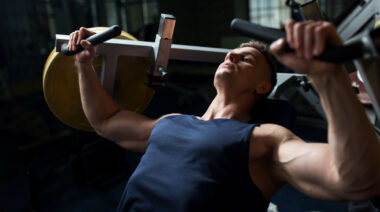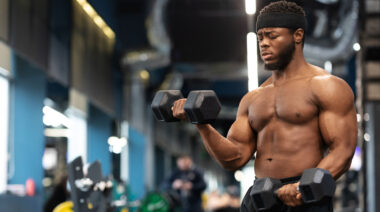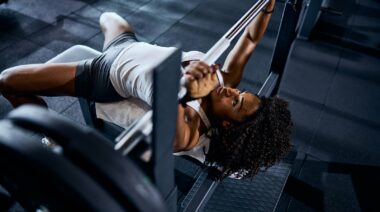If you’re here, it’s most likely because you have a life, a job, a family, and interests, passions, and commitments outside of the gym. But you still want to make a commitment to your health, and of course, look freaking awesome with your clothes off. And you want to do it in as little time as possible. Because you’ve got other stuff to do.
If you’re here, it’s most likely because you have a life, a job, a family, and interests, passions, and commitments outside of the gym. But you still want to make a commitment to your health, and of course, look freaking awesome with your clothes off. And you want to do it in as little time as possible. Because you’ve got other stuff to do.
This article will give you an honest and practical framework on how to structure and plan an effective training program using as little equipment as possible, in as little time as possible. This article will not give you a gimmicky “2-minute fat blasting booty detox magic secret workout” that promises unrealistically large results for an unrealistically small amount of work. This is still going to be hard work.
If you plan intelligently, and work effectively and efficiently, there is no reason that you cannot make significant progress with relatively minimal time and equipment.
You don’t need fancy equipment to get fit. [Photo credit: Shutterstock]
Getting Started
What you will need:
- 15 minutes a day on average
- A pull up bar
You might be thinking, “I thought you said no equipment?” While you can make decent progress without a pull up bar, the benefits of purchasing one greatly outweigh the cost. If you’ve got a door in your house (going out on a limb here, but I’m pretty sure you do), and enough money to buy a latte, you’ve got everything you need to get yourself a decent door-attaching pull up bar.
Just because 15 minutes a day is the minimum recommendation doesn’t mean that you won’t benefit from a little more time. If you can manage, 30 minutes a day is plenty to get optimal results for most people in most situations. Note how I said “on average.” This means that you can spread this time across your week as you like, so it could be as often as 7-minute workouts every day of the week, or two 50-minute workouts per week. It’s completely up to you and your schedule.
Figure Out Your Goals
First, you have to establish what you want to achieve from your training. Correct me if I’m wrong, but generally you want to:
- Lose fat and gain muscle, giving you the look commonly referred to as “toned.”
- Feel and move better in your day-to-day life.
Now let’s break down those two goals. To lose fat and gain muscle you need to follow a properly regimented training program that gives you balanced and progressive muscular development while taking up as little of your time as possible, along with a complementary nutrition plan.
To feel and move better, you need to do two things. First, develop a decent amount of cardiovascular capacity, enough that you can walk a few flights of stairs without feeling like you got run over by a truck, or more importantly, enough to have the energy to play with your kids or catch a pickup game of basketball with the boys. Second, claim and maintain basic positions that are pivotal to your joint and connective tissue health in the long-term. This involves a little bit of mobility work (i.e., stretching)
Looks like the basics are all settled. Now we can get into the nitty gritty.
The Importance of Progression and Movement Selection
This is one of the most fundamental things you need to grasp before getting started. No matter what sort of program you choose, you must focus on progression over time. If you don’t have that sorted, you are inevitably doomed to hit a plateau in your progress. So, how do we measure progress?
- Increasing volume and intensity over time. This means increasing your sets, reps, and/or load for your movements over the course of your training.
- Better movement quality/technique over time. Moving better, smoother, and with less pain. This could be something as simple as squatting a little deeper than you did the previous workout.
- Improved workload density. More work in less time. That’s all there is to it. This is a much better tool to measure your cardiovascular conditioning rather than your strength.
You understand that it’s important to progress on your “primary movements,” but what the hell should your primary movements be?
The goal is to base your program off of compound movements, which use minimal equipment, and will lead to balanced development in your body over time. The primary movements include a squat, press, and pull. You would then supplement your training with isolation movements to work on specific muscles that you’d like to give more attention to, like the arms, calves, or abs.
Points of Performance
Training with mainly bodyweight movements presents an issue when it comes to progressing over time: If you’re doing everything right, you will very quickly outgrow the basic starting points for each movement pattern. To combat this, here are some practical pointers to help you continue to make your movements more difficult as you progress over time.
Squats: Once a normal squat gets too easy, progress to more difficult unilateral movements. Here are the best ones in order of increasing difficulty:
- Lunges
- Cossack squats
- Bulgarian split squats
- Pistol squats
If you get to the point when you’re such a stud that pistols are too easy, you’re probably ready to get a small set of weights to hold in front or at your sides while you perform the movement.
Presses: The first step is to progressively increase the incline of your pushup. If you keep this up over a long period of time you’ll end up doing handstand pushups. And if you are dedicated and become strong enough that handstand pushups are a cake-walk you can go back to horizontal pushups, but with one hand this time.
Yup, that’s right, you’re practically Rocky.
Intensity, Volume, and Frequency
Manipulating the following three variables is the most powerful tool at your disposal for controlling your results:
- Intensity, in its purest sense, refers to how ‘heavy’ each movement is compared to your maximal output for said movement
- Volume is the amount of work you do for each movement. The balance of volume and intensity dictate how many sets and reps you do for each movement.
- Frequency is simply how often you do each movement.
Due to the nature of the bodyweight movements in this plan, it makes little sense to focus on the lower rep ranges (i.e., below 5). A solid home workout plan should keep rep ranges in the moderate (8-12) to high (15+) range. Just make sure that you don’t let your reps/set go anywhere above 25. Although hypertrophy is possible around this rep range, it’s definitely not optimal. On top of that, more reps equate to more time spent training, and we want to make the absolute most of our time.
Structure your training to work each major movement pattern at least twice a week. That can mean dedicating each day to a movement pattern, and training 6 days a week, or doing all three movement patterns in a single workout and training twice a week.
Here are some recommendations to get you started with rest intervals, rep temp, and training to failure:
Rest intervals: For most people in most cases, around 60-90 seconds between sets and 1-2 minutes between movements will give you plenty of time to recover, and allow you to get a lot of stimulus without taking up too much time.
Rep tempo: As long as you’re controlling both the eccentric and concentric part of each movement, and are not feeling any pain or discomfort at any point, you’ve got nothing else to worry about.
Training to Failure: Because you are working with bodyweight, low-risk, low-fatigue movements, going to failure on your final set will definitely go a long way in maximizing your progress. Keep an eye out for the common signs of over-reaching just in case it does start to catch up with you after a while.
Cardiovascular Conditioning
Since you’re on a time crunch, you need the maximum bang-for-your-buck when it comes to conditioning. And that’s where the Tabata protocol comes in. This thing is HIIT (high-intensity interval training) on cocaine.
In a nutshell, the Tabata protocol is 20 seconds of ‘work’, followed by 10 seconds of rest repeated 8 times. Sounds easy right. Trust me, you have never been more wrong. For a more in-depth look, check out the original experiment.
There are some important things to keep in mind when doing Tabata:
You can’t use the Tabata protocol with any movement. Ideally, it should be a low-skill, low-load exercise, which causes more cardiovascular fatigue than muscular fatigue. Some ideal candidates would be running, squats, jump squats, stair sprints, and burpees.
Do not try and use Tabata to build strength. It was designed specifically to improve cardiovascular conditioning in the shortest time possible, and this is precisely how it should be used. Perform the protocol at least two times a week, and a maximum of five. The latter is due to the relatively large recovery deficit that such an intense protocol creates.
Mobility Work
The bare minimums to claim and maintain your body’s vital movements and positions are simple:
- Squat bottom position
- Dead hang from a pull up bar
Supported heavily by movement specialists Ido Portal and Kelly Starrett, the simple act of sitting in the bottom of a bodyweight squat for a few minutes can do wonders for your body over time. Don’t worry too much about keeping a perfectly upright torso, but allow yourself to settle into a comfortable and sustainable position. Focus mainly on getting below parallel with your heels on the ground.?
The benefits of hanging from a pull up bar range from strengthening of connective tissue in your shoulder girdle to spinal decompression. When doing so, let your scapula spread at the bottom. Focus on not grabbing the bar too tightly, causing most of the tension to be borne by your hands, but use the hands as hooks, and let yourself hang in a free and relaxed manner.
Apart from these two drills, the use of a lacrosse ball to work out any particular pain points you might have is immensely helpful. And anything beyond that, will of course require some more specialized care.
An Aside on Proper Nutrition
No matter how on-point your training might be, if you don’t have your diet inline to meet your goals then all of it will likely go to waste. For the majority of folks, a flexible dieting approach, in which you count your macros on a day-to-day basis, will give you the best results, with the least restriction to the rest of your life.
Here are some key points to keep in mind when planning your nutrition:
- Always prioritize meeting your calorie goal.
- To lose weight, the single most important factor that needs to be achieved is a calorie deficit (i.e.,. eating less than your maintenance calories consistently over time)
- To gain weight, the single most important factor that needs to be achieved is a calorie surplus (i.e.,. eating more than your maintenance calories consistently over time)
- After that, make sure you get in adequate amount of protein and fat: at least 0.8 grams/lb of lean mass for protein, and at least 0.3 grams/lb of lean mass for fats.
How comfortable are you in the bottom of your squat?
Squat Therapy: 4 Drills for a Better Squat
Beginner Basic Bodyweight Strength Program
It would be just plain rude of me to dump all that information on you without offering a well-constructed program. So on that note, here’s a template based on a 3 day per week cycle.
Day 1
- Pull up (underhand grip): 2 sets of 10-12 reps
- Push up: 2 sets of 10-12 reps
- Bodyweight/goblet squat: 2 sets of 10-12 reps
- Hollow-body hold: 2 sets of 30 seconds
Day 2
- Pull up (neutral grip): 2 sets of 8-10 reps
- Bench dips: 2 sets of 8-10 reps
- Backward-stepping lunge: 2 sets of 8-10 reps
- Plank: 2 sets of 60 seconds
Day 3
- Pull up (overhand grip): 2 sets of 5-8 reps
- Incline push ups: 2 sets of 5-8 reps
- Jump squats: 2 sets of 5-8 reps
- Lying leg raises: 2 sets of 5-8 reps
Avoid adding resistance or moving to a more difficult movement before you are able to perform all the prescribed reps on the upper limit of the stated rep range. Try to get at least one day of rest between training days. And remember, never compromise technique.
Check out this list of fun workouts and simple exercises to do when stuck at home.






